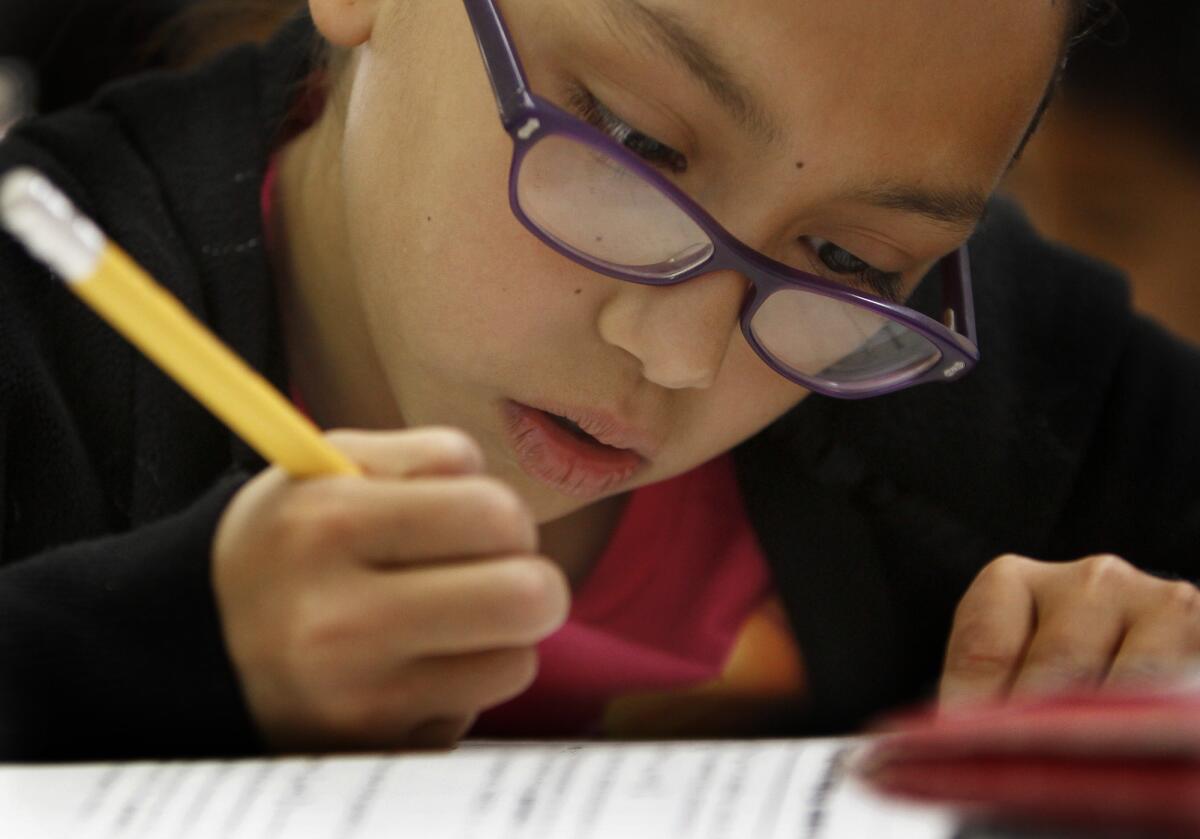Your kids take 112 tests between pre-K and high school

Zeimi Deleon focuses on problems during a math class at Los Angeles Elementary School in 2011.
- Share via
If you live in a big city, your child probably took eight standardized tests this year. On average, kids sit through 112.3 tests between preschool and high school graduation, according to a new study.
Is that too much?
Rancor around standardized testing dominated headlines this year, with some parents protesting the number, duration and quality of tests students take. But as they rallied, opined and opted out, one question remained unanswered: Precisely how many tests do American students really take, and why?
To answer those questions, the Council of the Great City Schools and the Council of Chief State School Officers conducted a study on the state of testing in America today. The 164-page study released Saturday scrutinized testing in America’s biggest cities, and found redundancies in tests mandated by government at all levels.
“You’ve got different entities at differing levels requiring assessments for purposes that aren’t connected,” said Michael Casserly, who heads the Great City Schools group. “It just adds up to an incoherent disconnected system.”
The findings reflect states’ efforts to implement new tests associated with the Common Core State Standards, a set of learning goals in English and math adopted by most states.
The results come before a busy week for standardized testing in the U.S. On Wednesday, the federal government is expected to release scores for the National Assessment of Educational Progress, the only national standardized test. Also this week is what some policymakers believe to be the small window Congress has to reconcile two competing House and Senate bills to replace the No Child Left Behind Act before House Speaker John Boehner (R-Ohio) leaves. At the center of the differences between the two bills is testing.
“Testing participation and test output and how to handle all that is one of the key unresolved issues,” said Kati Haycock, who heads the Education Trust, a Washington, D.C.-based advocacy group that supports federally mandated standardized tests as a way to see how different groups of students are learning. “Any heat around the testing issue can ricochet.”
The study looked at tests in 66 major city public school systems, including Los Angeles Unified. Those districts administered 401 different exams, and students sat for tests more than 6,570 times. Although Casserly did not have data for LAUSD specifically, he said that the overall numbers didn’t vary much from one district to another.
In 2014-15, LAUSD actually saw less testing than it previously had. “We were in a transition year,” said Cynthia Lim, the director of LAUSD’s Office of Data and Accountability, referring to the switch to the new Common Core exam called Smarter Balanced. Last year, LAUSD did not have “mandated periodic assessments” as in previous years.
Instead, the district made interim tests available to schools, but did not centrally collect the results, Lim said. The Smarter Balanced exams were administered in grades 3-8 and 11, and each subject test clocked in at four hours.
This year, the district is encouraging schools to use the interim tests that Smarter Balanced provides, but schools are not required to do so.
“We’re using this as an experimental year to see how the interim assessments go,” she said. “We have fewer tests than Florida. … I don’t know what the right mix is. We’re still trying to figure out what our assessment plan and comprehensive view of assessment should be for the next school year.”
Nationally, some educators, parents and others say they believe the emphasis on testing has gone too far.
“I think there is too much testing,” said Morgan Polikoff, a USC Rossier School of Education assistant professor. But he added that the report likely doesn’t reflect the amount of testing outside of cities. “The phenomenon on benchmark testing is an urban phenomenon,” he said.
Officials are listening. On Monday, U.S. Secretary of Education Arne Duncan and his deputy — and named successor — John King are hosting a panel to address the report. Also on Saturday, the Obama administration is releasing a “testing action plan” that lays out a pathway for fixing standardized testing in America.
The plan says that the only tests that should be given are those that are “worth taking,” meaning that they’re relevant; “high quality,” meaning that they require a student to use material in a complex manner; and “time-limited,” meaning that they take up no more than 2% of class time. Tests should also be “fair,” meaning that they’re accessible for students with disabilities, and “fully transparent,” meaning that parents receive information on the tests’ purpose.
“I can’t tell you how many conversations I’m in with educators who are understandably stressed and concerned about an overemphasis on testing in some places and how much time testing and test prep are taking from instruction,” Duncan said in a statement.
The U.S. Education Department is trying to reduce the burden of testing on students by adding these criteria to grants and asking Congress for funding to develop better tests.
The federal government also committed to releasing “clear guidance” on how to use federal money for testing audits by January 2016. It will establish “office hours” for states with testing questions to get help. Previously, the feds have invited states to apply for waivers to get out of certain extra testing requirements, an offer California has put into place.
“Duplicative, unnecessary or poor-quality, low-level tests subtract from learning time and undermine instruction,” King said. “There are too many tests that do not provide useful information.”
You can reach Joy Resmovits on Twitter @Joy_Resmovits and by email at joy.resmovits@latimes.com.
More to Read
Sign up for Essential California
The most important California stories and recommendations in your inbox every morning.
You may occasionally receive promotional content from the Los Angeles Times.














